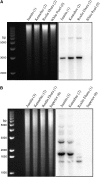Three potato centromeres are associated with distinct haplotypes with or without megabase-sized satellite repeat arrays
- PMID: 24318533
- PMCID: PMC3914613
- DOI: 10.1534/genetics.113.160135
Three potato centromeres are associated with distinct haplotypes with or without megabase-sized satellite repeat arrays
Abstract
We report discoveries of different haplotypes associated with the centromeres of three potato chromosomes, including haplotypes composed of long arrays of satellite repeats and haplotypes lacking the same repeats. These results are in favor of the hypothesis that satellite repeat-based centromeres may originate from neocentromeres that lack repeats.
Keywords: Centromere; centromere evolution; neocentromere; placeholder; satellite repeat.
Figures



References
-
- duSart D., Cancilla M. R., Earle E., Mao J. I., Saffery R., et al. , 1997. A functional neo-centromere formed through activation of a latent human centromere and consisting of non-alpha-satellite DNA. Nat. Genet. 16: 144–153. - PubMed
Publication types
MeSH terms
Substances
LinkOut - more resources
Full Text Sources
Other Literature Sources

